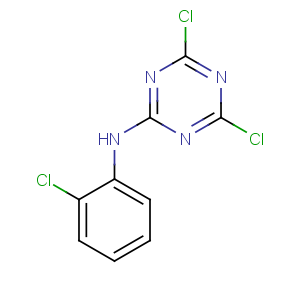Title: Anilazine
CAS Registry Number: 101-05-3
CAS Name: 4,6-Dichloro-
N-(2-chlorophenyl)-1,3,5-triazin-2-amine
Synonyms: 2,4-dichloro-6-(
o-chloroanilino)-
s-triazine; (
o-chloroanilino)dichlorotriazine
Trademarks: Dyrene (Bayer)
Molecular Formula: C9H5Cl3N4
Molecular Weight: 275.52
Percent Composition: C 39.23%, H 1.83%, Cl 38.60%, N 20.33%
Literature References: Prepn: C. N. Wolf,
US 2720480 (1955 to Ethyl Corp.); E. G. Hill, E. Clinton,
US 2820032 (1958); K. H. Rattenburg
et al., US 3074946 (1963 to Chemagro). Toxicity study: S. D. Cohen, S. D. Murphy,
J. Agric. Food Chem. 21, 140 (1973).
Properties: White to tan crystals, mp 159-160°. Insol in water. Soly at 30° (g/100 ml): toluene, 5; xylene, 4; acetone, 10. Subject to hydrolysis; not compatible with oils and alkaline materials. LD50 orally in rats: >5000 mg/kg, Mobay Technical Information Sheet, Jan. 1979.
Melting point: mp 159-160°
Toxicity data: LD50 orally in rats: >5000 mg/kg, Mobay Technical Information Sheet, Jan. 1979
Use: Fungicide.

